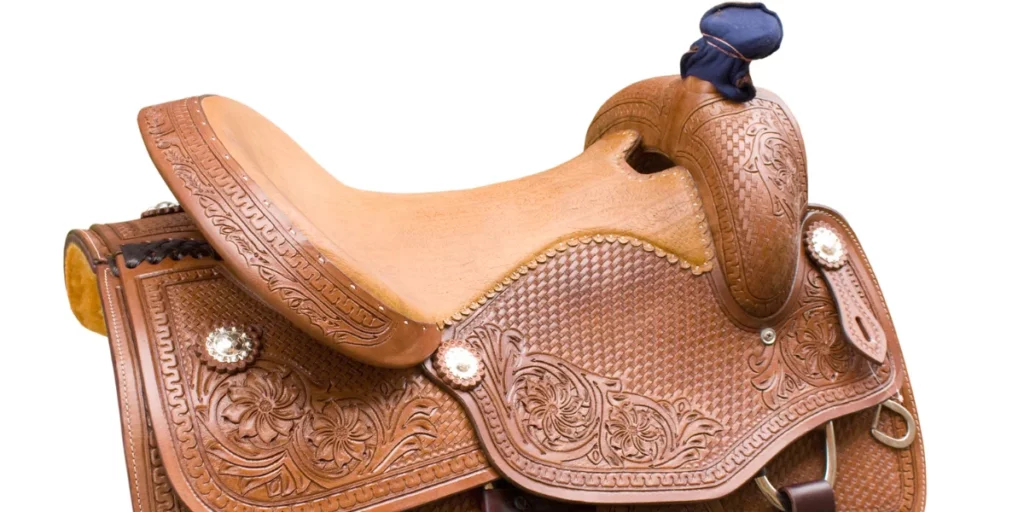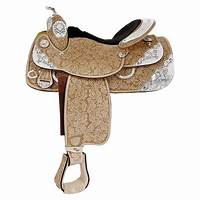
Getting a new saddle is exciting—just like getting a brand-new car! The fresh leather, the perfect fit, and that unmistakable new saddle smell. But then reality sets in… the leather is stiff, the fenders aren’t budging, and your stirrups are pointing in all the wrong directions.
Breaking in a saddle takes time, but with the right techniques, you can soften the leather, shape the fenders, and make your ride comfortable much faster.
This stiffness comes from fresh, unworn leather, and believe me, it’s anything but flexible at first. Think of it like breaking in a brand-new pair of Doc Martens—tough at the start, but worth it in the end!
A stiff saddle isn’t just uncomfortable for your horse, it’s no picnic for you either.
The hard leather can create pressure points, leading to soreness, or even blisters especially on the seat and thighs, making every ride feel like you’re sitting on a board instead of a nice comfy seat.
Breaking in a saddle ain’t just for comfort, it’s crucial for its longevity too. A well-broken-in saddle molds to both you and your horse over time, making each ride smoother. Plus, you get more bang for your buck since the saddle lasts longer and performs way better.
The advantages go beyond just comfort and durability. Picture less rubbing and fewer injuries for your horse. When broken in right, a saddle enhances your riding experience. In this guide, we’ll walk you through tried-and-true methods to get your saddle feeling like it’s been custom-made just for you.
Step-by-Step Guide to Breaking in Your New Saddle
Conditioning the leather is your first step to saddle bliss. Think of it like giving your saddle a good massage. Use the right oils and conditioners—bee’s wax or neatsfoot oil work wonders—to bring some much-needed flexibility and softness. Just don’t go overboard. A little dab’ll do ya, otherwise, you’re risking some greasy regrets.
Now, to really get things going, it’s all about the ride. Short initial rides are the way to go, gradually extending them as you feel the saddle softening and molding. It’s like baby steps for your saddle, easing it into its future shape.
Then there’s the duo of heat and moisture, which can help soften the leather enough to make it more pliable. Place it in a warm spot or use a hairdryer on low, and consider using a damp cloth. Be careful though, you don’t wanna overdo it and damage that beautiful leather.
Those stiff fenders and stirrup leathers? They need some TLC too. Try twisting them back and forth to break the initial rigidity. You can hang weights on them or even twist and tie them overnight to help the process along.
Lastly, let gravity do its thing with a saddle stand. It lets your saddle take on a more natural shape when not in use, like a comfy couch for your trusty equipment. This way, it’s ready and waiting for your next venture into the wild.
Avoiding Common Mistakes When Breaking In a Saddle
Everyone makes mistakes, but let’s keep yours to a minimum when you’re breaking in that saddle.
First on the list of don’ts is over-conditioning the leather. Sure, it’s tempting to slather on the oil like you’re basting a turkey, but too much and you’ll end up with a greasy, heavy mess that’s worse than a sticky steering wheel on a hot day.
As for using heat and water, moderation’s key. Excessive heat might toughen the leather rather than softening it, and too much water can warp it. Think of it like making toast—crispy is good, burnt is not so good.
And be patient, rushing the saddle’s adjustment process is a common mistake.
Give it the time it needs to naturally adapt to you and your horse. If you push it, it’ll only lead to discomfort and a saddle that’ll never quite feel right.
Avoiding shortcuts pays off in the long run. Breaking in a saddle is as much about the journey as the destination. A little effort now means a lot less hassle later, letting you and your horse ride off into the sunset with ease.
Conclusion: Achieving Saddle Comfort with Patience and Care
Breaking in a saddle is all about patience and some tender loving care.. Getting the fit right might feel like a slow process, but it’s worth every minute for the comfort you’ll gain.
Keeping up with regular maintenance is your ticket to saddle longevity. Regularly check and condition the leather to avoid dry spots that could spell trouble later. Making this a part of your routine ensures not just comfort but a longer lifespan for your favorite riding gear.
Consider these care habits as an investment in your riding future. Every time you oil that leather or secure it on its stand, you’re getting closer to a saddle that fits like a glove, ready for adventures both great and small.
Have you ever had to break in a stiff saddle? What tricks or methods worked best for you? Share your experience in the comments below—I’d love to hear your tips and stories!

